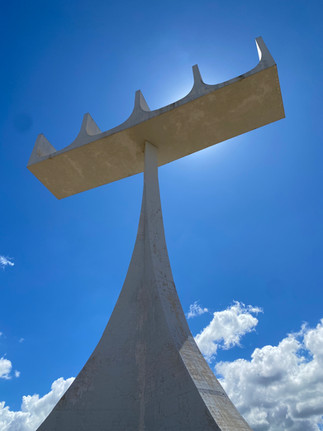Discover Brasília: A Traveler’s Guide to Brazil’s Futuristic Capital City
- Will Gerson
- Jul 18
- 2 min read
Updated: Nov 20
Brazil’s futuristic capital is a city unlike any other, built from scratch on a 3,300-foot (1,000m) plateau over the course of just three and a half years. Inaugurated in 1960 to replace Rio de Janeiro as the national capital, Brasília is the brainchild of urban planner Lúcio Costa and architect Oscar Niemeyer, who sought to design a city that would serve as a literal and figurative symbol of modernity.

Laid out in the shape of an airplane, the most important government buildings are located along the fuselage, while the two wings comprise the main residential areas of the city. Drawing inspiration from Le Corbusier’s Ville Radieuse (Radiant City), the residential wings are divided into superquadras, small housing blocks consisting of apartments, businesses, and recreation areas that would serve as self-sufficient miniature neighborhoods.

Though Brasília can be a bit difficult to wrap your head around, it’s well worth a visit for its architectural beauty and its importance as the nation’s capital. Its unique, semi-utopian feel won’t be everyone’s cup of tea, but the result is a city that has one of the highest per capita GDPs in the region and is relatively free from many of the problems that plague other large cities in Brazil and throughout South America, such as high rates of crime and homelessness.

Read on for a guide to some of the city’s main points of interest. They are conveniently located around the Eixo Monumental (Monumental Axis), so they can be easily visited in a couple of hours.
Catedral Metropolitana de Brasília
One of the city’s highlights is its cathedral, one of Niemeyer’s masterpieces. Visually striking from the outside, the cathedral’s interior is truly breathtaking, as you can fully appreciate the hyperboloid stained glass windows stretching upward toward the heavens.
Palácio Itamaraty
Home to the Ministry of Foreign Affairs, this building, with its characteristic arches, is famous for its landscaping designed by the famed Brazilian landscape architect Roberto Burle Marx.

Palácio do Congresso Nacional
Another of Niemeyer’s great modernist works, the National Congress complex is made up of a downward-facing hemisphere on the left, seat of the Senate, and an upward-facing hemisphere on the right, seat of the Chamber of Deputies, separated by twin vertical office towers in the middle.

Praça dos Três Poderes
Directly behind the National Congress is the Plaza of the Three Powers, located in the ‘cockpit’ of the city’s airplane layout. This plaza both literally and metaphorically represents the harmonious connection of the three branches of government: the legislative (National Congress), executive (Palácio do Planalto, the presidential office), and judiciary (Supremo Tribunal Federal, the country’s supreme court).

In the center of the plaza, you will find the 26-foot tall (8 m) bronze statues known as Os Candangos, built in homage to the workers from the country’s northeast who built the capital city, as well as the lovely Casa de Chá, a visitors center and cafe with some exceptional pão de queijo.
Looking for more places to explore? Visit our Brazil page here.













